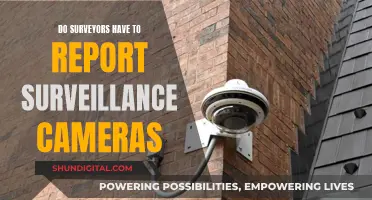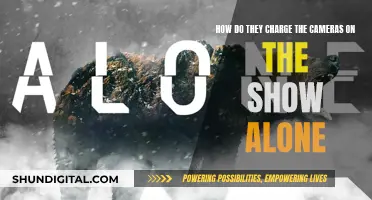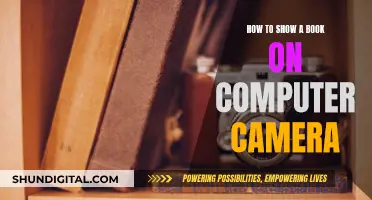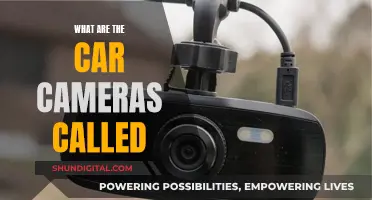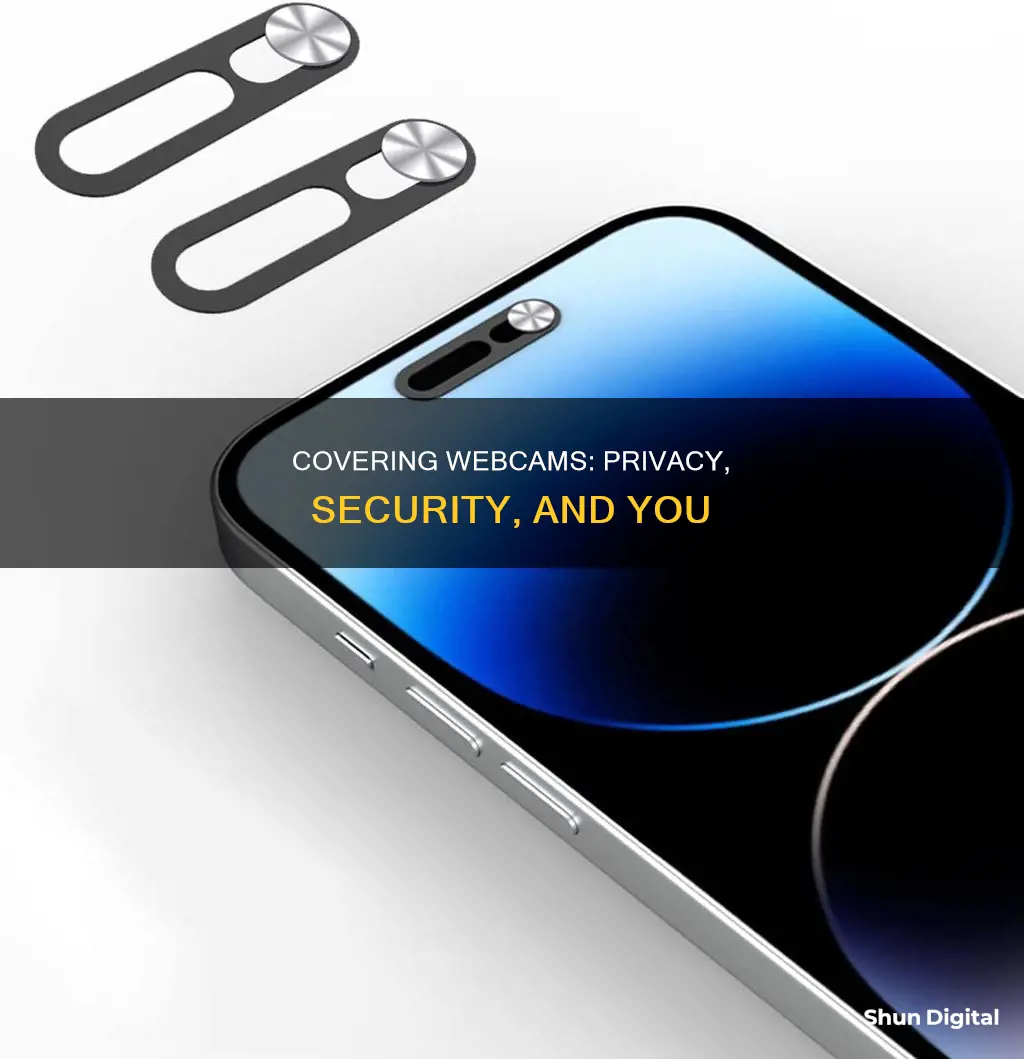
Covering the camera on your computer is a privacy and security measure that has gained popularity in recent years. While some may consider it a paranoid act, there are legitimate concerns about the potential risks of leaving your webcam exposed. These include accidental activation during video calls, malware attacks, and hacking attempts by cybercriminals aiming to extort or socially engineer attacks using captured images or footage. While the likelihood of these incidents may be low, many individuals prefer to take precautions to protect their privacy. Additionally, it is a simple and inexpensive solution, often achieved with tape, stickers, or sliding covers.
| Characteristics | Values |
|---|---|
| Reason for covering | To prevent hackers from accessing the camera |
| To avoid accidental sharing of surroundings during video calls | |
| To prevent malware attacks | |
| To avoid embarrassment | |
| To ensure control over when to be seen on camera | |
| To prevent cybercriminals from taking photos or videos | |
| To protect privacy | |
| Methods of covering | Tape (invisible, duct, washi, painter's) |
| Stickers | |
| Post-its | |
| Sliding webcam cover | |
| Square webcam cover | |
| Privacy shield |
What You'll Learn

Prevent accidental sharing of surroundings during video calls
If you are someone who regularly uses video conferencing software such as Zoom or Skype, you may want to cover your webcam to avoid accidentally sharing your surroundings during video calls. This is especially important if you work remotely and want to maintain a level of privacy.
By covering your webcam, you can prevent others from seeing your surroundings, which may include sensitive or confidential information. This is a simple yet effective way to protect your privacy and maintain a professional appearance during video calls.
There are various ways to cover your webcam, from using tape or a Post-it note to investing in a sliding webcam cover or a square webcam cover that can be easily removed when needed. These methods provide a barrier between you and your camera, ensuring that your surroundings remain private.
Additionally, it is important to double-check that your video is turned off before and after each meeting. Being cautious about your surroundings and what might show up on camera can also help prevent accidental sharing. Taking these simple precautions can enhance your privacy and give you greater peace of mind during video calls.
Unlocking Camera Raw: Load Your Presets Like a Pro
You may want to see also

Avoid potential malware attacks
Covering your webcam is a simple, low-tech solution to preventing webcam hacking, a type of online attack also known as "camfecting". This occurs when hackers take control of your webcam remotely, disabling the "on" light so that you are unaware that the camera has been activated.
Webcam hacking is usually done with a remote administration tool (RAT), which accounts for upwards of 70% of all Trojans. This is a type of malware that hides on PCs to track someone’s online activity and sometimes take control of the device. RATs are relatively easy to build and deploy, and they allow hackers to capture video without your knowledge.
Hackers can install malware and access computers, tablets, security, and Internet of Things (IoT) device cameras. If successful, they can use the footage for blackmail and identity theft. They can also use the opportunity to access files, photos, banking details, and a range of other data.
How to Protect Yourself
- Use tape or a sticker to cover your webcam: This is a quick, easy, and inexpensive solution. You can use clear tape, duct tape, or washi tape, or opt for a cute sticker.
- Install a sliding webcam cover: Search online for webcam slides, which attach directly to the top of your laptop or computer.
- Place a square webcam cover over your camera: This type of cover blocks the camera completely and can be easily removed.
- Use a privacy shield: A privacy shield forces your device to point in a single direction, making it difficult for hackers to get a good view of your surroundings.
- Keep your devices updated: Regular software updates often patch vulnerabilities, helping to keep your device secure and prevent bad actors from accessing your computer camera.
- Use a virtual private network (VPN): A VPN encrypts your network connection, helping to secure your online communications, conceal your identity and IP address, and protect you when using public Wi-Fi.
- Install security software: Choose software that can help safeguard your devices against viruses, spyware, and other malware.
- Use a reliable antivirus program: Opt for one with advanced protection against malware, spyware, and viruses. An antivirus program will detect and bust malicious threats before they can do any harm.
- Be cautious of phishing attempts: Hackers may disguise themselves as support agents or send phishing emails with spoofed URLs and malicious files. Treat emails from unknown senders with caution and don’t click on suspicious links or download attachments.
- Be wary of public Wi-Fi: Public Wi-Fi networks are extremely vulnerable to hacking. Always use a VPN to secure your Wi-Fi connection and protect yourself from unwanted snoopers.
- Use strong passwords: Create strong passwords and don’t reuse them on different accounts. Repeat passwords make it easy for cybercriminals to break into your accounts and find personal information.
- Lock down your network with a firewall: A firewall helps stop unauthorized users from accessing or controlling your webcam, among other things.
Wired Lorex Cameras: How Long Do They Last?
You may want to see also

Protect against hackers
Covering your camera on your computer is a simple yet effective way to protect yourself from webcam hacking, also known as "camfecting". This involves a hacker taking control of your webcam to spy on you, steal sensitive information, or even blackmail you.
How Webcam Hacking Works
Webcam hacking usually occurs when a hacker infects your device with a virus or malware, such as a remote administration tool (RAT) or Trojan. This gives them unauthorised access to your webcam, allowing them to view and record footage without your knowledge or consent.
Warning Signs of Webcam Hacking
There are several warning signs that may indicate your webcam has been hacked:
- The indicator light is on or blinking even when you're not using the webcam.
- New, unfamiliar files appear on your device.
- Background apps are using an unusual amount of data or battery.
- Settings have changed without your input.
- The camera glitches or crashes unexpectedly.
Steps to Protect Yourself
In addition to covering your webcam, there are several other measures you can take to protect yourself:
- Update your operating system: Regular updates can patch vulnerabilities and help secure your device.
- Use a firewall: A firewall monitors network traffic and blocks unauthorised access to your webcam.
- Create strong passwords: Avoid reusing passwords across different accounts to reduce the risk of cybercriminals gaining access to your information.
- Avoid suspicious links and phishing attempts: Be cautious when clicking links or downloading attachments, especially from unknown senders.
- Use a virtual private network (VPN): A VPN encrypts your network connection, protecting your online communications and concealing your identity and IP address.
- Install security software: Use trusted security software to safeguard your device against viruses, spyware, and malware.
By taking these proactive measures, you can significantly reduce the risk of webcam hacking and improve your overall cybersecurity posture.
Traffic Surveillance: Beating Violations with Camera Evidence
You may want to see also

Prevent accidental sharing of personal data
While covering your computer camera may seem paranoid, it is a simple and effective way to prevent accidental sharing of personal data. With remote working and video conferencing becoming the norm, it is easy to forget that your camera is on and accidentally share your surroundings with colleagues or strangers. A piece of tape, a sticker, or a sliding webcam cover can ensure that your camera is blocked when not in use, giving you peace of mind and an extra layer of security.
Accidentally leaving your camera on during a video call can be embarrassing and potentially reveal sensitive information. By covering your camera, you can control what others see and prevent any unintended disclosures. This is especially important if you have multiple cameras set up, as the wrong default camera may activate and transmit information you didn't intend to share.
Additionally, covering your camera can protect you from potential hacking attempts. While the chances of being hacked are slim, it is still a valid concern. Hackers can gain remote access to your computer through various means, such as tricking you into installing malicious software or exploiting software bugs. With access to your camera, they can take photos or videos and use them for extortion or social engineering attacks. By covering your camera, you add an extra layer of protection, ensuring that even if someone gains access to your computer, they cannot see your surroundings.
Beyond covering your camera, there are other preventative measures you can take to enhance your cybersecurity. This includes regularly checking which apps have access to your camera, uninstalling unused apps, using strong passwords, and being cautious when opening emails from unknown senders. By combining these measures with a simple camera cover, you can significantly improve your online privacy and security.
Unleash Camera Raw's Power: Discovering MIROE
You may want to see also

Ensure peace of mind
Covering your computer camera can be an effective way to address privacy concerns and prevent potential security breaches. While some may consider it a paranoid act, there are valid reasons why many people choose to take this precaution.
Firstly, it is a simple yet effective measure to prevent accidental disclosures or unintended recordings. By physically covering your camera, you eliminate the possibility of unintentionally leaving your video camera on or transmitting information when you don't want to. This adds an extra layer of control over your privacy, ensuring that you decide when and how others can see you through your camera.
Secondly, it provides protection against potential hacking attempts. While the likelihood of being hacked may be slim, it is not unheard of for cybercriminals to gain remote access to computers and capture photos or videos. They may use this footage for various malicious purposes, including extortion and social engineering attacks. By covering your camera, you add a physical barrier that makes it more challenging for hackers to invade your visual privacy, even if they gain access to your computer.
Additionally, a camera cover can be particularly useful if you work remotely or frequently participate in video calls. It ensures that your surroundings remain private and are not accidentally exposed during meetings or calls. This can be important if you want to maintain a professional image or protect sensitive information in your workspace.
Furthermore, covering your camera can prevent unwanted access by malicious app developers. In some cases, apps with malicious intent may capture or steal data through your camera without your knowledge. A physical cover ensures that even if an app has camera permissions, it cannot access your camera's feed.
While covering your camera is a good first step, it is important to note that comprehensive cybersecurity involves multiple layers of protection. This includes measures such as keeping your devices updated, installing antivirus software, using secure passwords, and being cautious when opening emails or links from unknown sources. By combining a camera cover with these additional precautions, you can significantly enhance your privacy and peace of mind.
Transferring Photos: Camera Chip to Computer
You may want to see also
Frequently asked questions
Covering your camera with tape, stickers, or a sliding webcam cover can prevent accidental sharing of your surroundings during a meeting. It can also protect you from hackers, although the likelihood of this is slim.
You can use tape (invisible, duct, or washi), stickers, or a sliding webcam cover.
You can disable your video by default, use virtual backgrounds, uninstall unused apps, and be cautious about which apps have access to your camera.
If your camera turns on accidentally due to a software bug, this could be a sign that your computer has been hacked.



